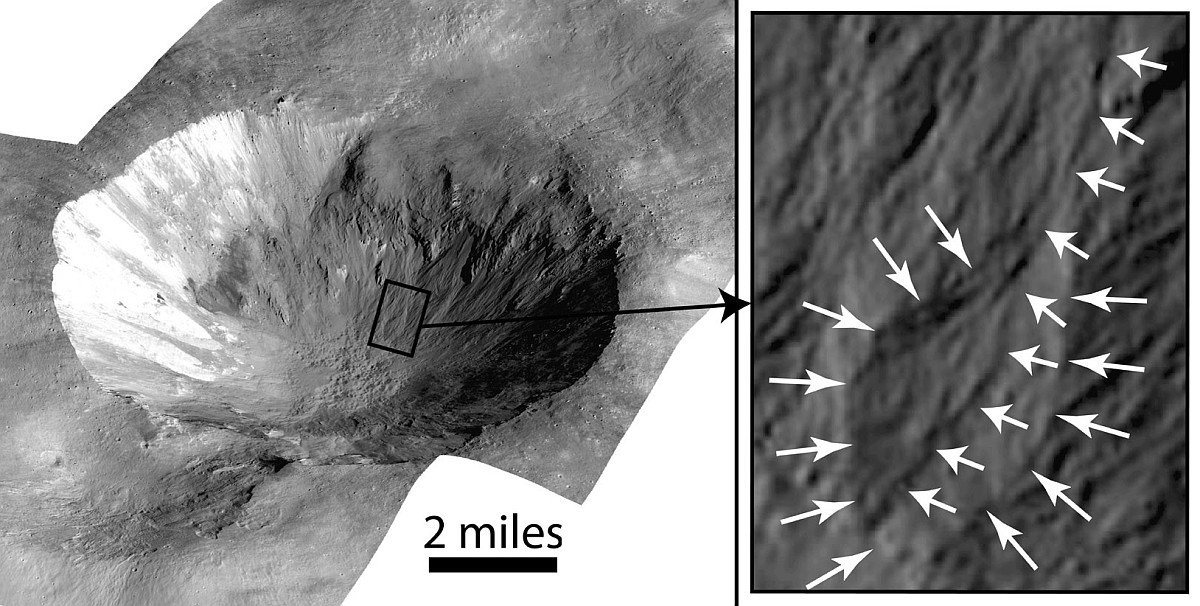Lab tests suggest water brines could also exist on large asteroids
In attempting to explain the existence of flow features that have been found on the interior walls of craters on the asteroids Ceres and Vesta — as shown in the image above — scientists recently performed a laboratory experiment which determined that a mixture of water and salt could produce those gullies.
The team modified a test chamber at the Jet Propulsion Laboratory to rapidly decrease pressure over a liquid sample to simulate the dramatic drop in pressure as the temporary atmosphere created after an impact on an airless body like Vesta dissipates. According to Poston, the pressure drop was so fast that test liquids immediately and dramatically expanded, ejecting material from the sample containers.
“Through our simulated impacts, we found that the pure water froze too quickly in a vacuum to effect meaningful change, but salt and water mixtures, or brines, stayed liquid and flowing for a minimum of one hour,” said Poston. “This is sufficient for the brine to destabilize slopes on crater walls on rocky bodies, cause erosion and landslides, and potentially form other unique geological features found on icy moons.”
The press release makes it sound as if this result makes the existence of subsurface water ice more likely on such asteroids as Ceres and Vesta, but previous research from the Dawn asteroid probe made that fact very clear, especially for Ceres, years ago. All this does is provide some evidence of what might be one process by which these erosion gullies form.
Hat tip to reader Milt.
On Christmas Eve 1968 three Americans became the first humans to visit another world. What they did to celebrate was unexpected and profound, and will be remembered throughout all human history. Genesis: the Story of Apollo 8, Robert Zimmerman's classic history of humanity's first journey to another world, tells that story, and it is now available as both an ebook and an audiobook, both with a foreword by Valerie Anders and a new introduction by Robert Zimmerman.
The print edition can be purchased at Amazon or from any other book seller. If you want an autographed copy the price is $60 for the hardback and $45 for the paperback, plus $8 shipping for each. Go here for purchasing details. The ebook is available everywhere for $5.99 (before discount) at amazon, or direct from my ebook publisher, ebookit. If you buy it from ebookit you don't support the big tech companies and the author gets a bigger cut much sooner.
The audiobook is also available at all these vendors, and is also free with a 30-day trial membership to Audible.
"Not simply about one mission, [Genesis] is also the history of America's quest for the moon... Zimmerman has done a masterful job of tying disparate events together into a solid account of one of America's greatest human triumphs."--San Antonio Express-News
In attempting to explain the existence of flow features that have been found on the interior walls of craters on the asteroids Ceres and Vesta — as shown in the image above — scientists recently performed a laboratory experiment which determined that a mixture of water and salt could produce those gullies.
The team modified a test chamber at the Jet Propulsion Laboratory to rapidly decrease pressure over a liquid sample to simulate the dramatic drop in pressure as the temporary atmosphere created after an impact on an airless body like Vesta dissipates. According to Poston, the pressure drop was so fast that test liquids immediately and dramatically expanded, ejecting material from the sample containers.
“Through our simulated impacts, we found that the pure water froze too quickly in a vacuum to effect meaningful change, but salt and water mixtures, or brines, stayed liquid and flowing for a minimum of one hour,” said Poston. “This is sufficient for the brine to destabilize slopes on crater walls on rocky bodies, cause erosion and landslides, and potentially form other unique geological features found on icy moons.”
The press release makes it sound as if this result makes the existence of subsurface water ice more likely on such asteroids as Ceres and Vesta, but previous research from the Dawn asteroid probe made that fact very clear, especially for Ceres, years ago. All this does is provide some evidence of what might be one process by which these erosion gullies form.
Hat tip to reader Milt.
On Christmas Eve 1968 three Americans became the first humans to visit another world. What they did to celebrate was unexpected and profound, and will be remembered throughout all human history. Genesis: the Story of Apollo 8, Robert Zimmerman's classic history of humanity's first journey to another world, tells that story, and it is now available as both an ebook and an audiobook, both with a foreword by Valerie Anders and a new introduction by Robert Zimmerman.
The print edition can be purchased at Amazon or from any other book seller. If you want an autographed copy the price is $60 for the hardback and $45 for the paperback, plus $8 shipping for each. Go here for purchasing details. The ebook is available everywhere for $5.99 (before discount) at amazon, or direct from my ebook publisher, ebookit. If you buy it from ebookit you don't support the big tech companies and the author gets a bigger cut much sooner.
The audiobook is also available at all these vendors, and is also free with a 30-day trial membership to Audible.
"Not simply about one mission, [Genesis] is also the history of America's quest for the moon... Zimmerman has done a masterful job of tying disparate events together into a solid account of one of America's greatest human triumphs."--San Antonio Express-News



I remember some reports of salt on Ceres, half a decade ago:
https://behindtheblack.com/behind-the-black/points-of-information/cryovolcanism-on-ceres-still-ongoing/
https://behindtheblack.com/behind-the-black/points-of-information/ceres-bright-spots-in-occator-crater/